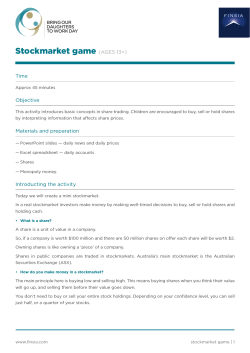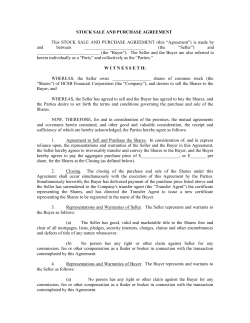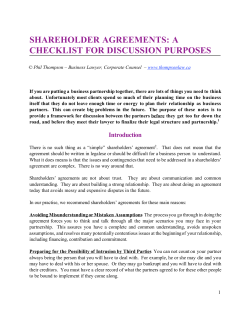
How to Turn Your Brokerage Account Into an ATM
A Publication of The Sovereign Society How to Turn Your Brokerage Account Into an ATM By Jeff D. Opdyke, Executive Editor The Sovereign Society 55 N.E. 5th Avenue, Suite 200 Delray Beach, FL 33483 USA USA Toll Free Tel: (888) 272-0413 Contact: http://sovereignsociety.com/contact-us Website: www.sovereignsociety.com How to Turn Your Brokerage Account Into an ATM A lot of investors are looking for investment income these days. Unfortunately, 99% of Americans who want income either buy bonds or dividend-paying stocks. They think that’s the best way to generate income. But the truth is that there’s a much better way. In fact, after you learn how to use this income strategy, you may never want to buy another stock again. The income strategy I’m about to show you allows you to collect five to 10 times more income than ordinary strategies … with a much lower risk. And you’ll be able to collect these payouts even during the coming monetary crisis. Let me show you how it works … How to Boost Your Income by Five to 10 Times Let’s use Wal-Mart (NYSE: WMT) as an example. Right now, I see that Wal-Mart is paying a 2.42% dividend. So if you invest $10,000 in Wal-Mart today, that means you’d get a dividend payment of $242 per year. Wal-Mart pays dividends every quarter, which means you’d be getting a check for $60.50 every three months. That’s not much, especially for a $10,000 investment. I mean, will $242 a year really make a huge difference for your retirement? The Center for Retirement Research at Boston College estimates that retirees need about 85% of their working income in order to maintain their standard of living during retirement. Getting a check for around $61 every three months isn’t enough. The good news is that there’s a better way to generate income. Using my strategy, you can collect a yield of 12% using shares of Wal-Mart. Using the same $10,000, that’s $1,200 a year, instead of just the $242 that you could collect with dividends. That’s five times higher than the dividends … and you can collect it right now. You don’t have to wait all year for a check. If you haven’t figured it out by now, I’m talking about selling put options. I know that you’re probably thinking that options are risky. But this is one of the biggest myths on Wall Street. How to Use Options to Reduce Risk Before I tell you a little more about this strategy, let me ask you something: Do you think driving a car is risky? Well, I think it really depends on how you’re driving, right? I mean, if you drive carefully, follow the speed limits and all the traffic regulations, driving isn’t risky. But if you drive recklessly after drinking a bottle of whiskey, driving a car can be really risky. It’s the same thing with options. They are risky — but only if you don’t know how to use them. The problem is that most investors use options to make risky and speculative trades. They want to get rich quick. They buy options to speculate on the direction of the market. 2 But it’s extremely hard to time the markets. That’s why most of them end up losing money. And that’s essentially what has created the misconception that options are risky. Think about this for a minute: If those who are buying options are losing money, those who are selling them must be making tons of money. That’s why selling options is a great way to safely generate extra income. Selling options means you’re not making any bets on the direction of the market. You’re simply collecting income. If you’re at or close to retirement, you can’t afford to take big risks. That’s why this strategy is a no-brainer. By now, you’re probably thinking: “What’s the catch?” Buying Stocks You Want at a Discount Let’s say you decide to sell a put option. When you do that, you’re agreeing to buy someone else’s shares of a particular stock for a set price for a limited period of time. In return for agreeing to buy the stock, you receive a cash premium from the other party. The buyer of the put option will exercise their right to sell you their stock if the price of the shares falls below the strike price. You’ll only be asked to fulfill that obligation if the stock closes below the strike price at expiration date. And that’s the biggest risk you will take. You will buy the stock for the strike price … a stock you wanted to buy anyway. Let’s look at the Wal-Mart option I mentioned above. Right now, shares of Wal-Mart are trading for about $78. Let’s say you want to buy shares of Wal-Mart today. Instead of paying $78, you can sell a put option with a $75 strike price. You will collect income, while agreeing to buy shares of Wal-Mart for $75. If Wal-Mart is trading below $75 at expiration, you will buy Wal-Mart for $75. And that’s the risk of selling puts. But remember, you were willing to pay $78 for the shares, so paying $75 is not really a problem. You’re buying shares of Wal-Mart at a discount, while generating income at the same time. That’s why once you learn how to do this, you may never want to buy stocks the old-fashioned way. An Example of Put Selling When you sell a put option, you collect the premium regardless of what happens. But the trade has two possible outcomes: 1. The option expires worthless, and you collect the entire premium without any obligation. 2. The buyer exercises the option, and you end up buying shares at the strike price. Let’s take a closer look at those two possible outcomes, and I’ll show you why selling puts the right way is a win-win situation. The Option Expires Worthless Let’s say we would like to buy Intel (Nasdaq: INTC), the giant chip maker. So we’d be willing to buy Intel at the 3 market price. But instead of buying the stock, we’d sell puts. I’ll use an example from December 3, 2013, when Intel was trading at $23.55. We would sell the March 2014 $23 put option. The option’s current price is $0.88. But since one option contract covers 100 shares, we’d collect $88 ($0.88 times 100) for every contract we sold. The buyer of this option would have the right to sell the stock to us for $23 (the strike price) at the expiration date, which is March 20, 2014, in this case. Of course, the buyer would only exercise their option if the stock traded below that price. If Intel were trading at $30, for example, the buyer would just sell it at the market price. The holder of the option would have no reason to sell the stock when they could get more in the open market. As a result, as long as shares of Intel traded for more than $23 at the expiration date, we’d book the entire premium with no obligation to buy the shares. And remember, you’d collect $88 if you sold one contract. If you sold five, you’d collect $440 ($88 multiplied by 5). The Anatomy of a Put Option Premium: This is the option’s price. This is the amount we’ll collect when we sell puts. Expiration Date: Stock options expire on the third Friday of the month. Exercise: When a put buyer “exercises” their option, they engage their right to sell the stock at the strike price. Strike Price: This is the price at which the buyer can “exercise” the option. When you sell a put option, you are required to buy shares at the strike price, if the buyer exercises their option. In the Money: Puts are “in the money” if the price of the stock is lower than the strike price. (A put with a $21 strike price is “in the money” with the stock at prices below $21, for example, $20.50.) Out of the Money: Puts are “out of the money” if the price of the stock is higher than the strike price. (A put with a strike price of $21 is “out of the money” if the stock is above $21.) This may not seem like much. But the truth is that this is an amazing strategy. Here’s why … Intel recently paid a quarterly dividend of $0.23. In other words, if you had 100 shares of Intel, you’d receive a payment of $23. By selling puts, we could collect $88 instead. We would be able to collect an “instant dividend” nearly four times higher than the regular dividend, without owning the stock. That would be a yield of about 4% ($0.88 divided by $23) in a little more than three months. If you sold three other put options during the year, you could collect an annual yield of 16%. And the results can get even better if you use a margin account. Cash-Secured and Naked Puts There are two ways to sell put options: cash-secured or naked. When you sell cash-secured options, there’s no margin account. Instead of depositing in a margin account with a broker, you’ll have to deposit a cash balance equal to the option’s exercise price. That guarantees you will have enough money in your account to buy the shares if the option is exercised. Let’s use the above example. Let’s say you have an account of $50,000. When you sell that put option on Intel, the broker will “freeze” $2,300, which is the amount you will need to buy 100 shares of Intel at $23, the strike price. That’s the way the broker secures the cash for the transaction. And if the option expires worthless, the broker simply releases the $2,300 back to your account. So keep this in mind when you decide how many contracts to sell. Using the example of Intel, if you decide to sell five contracts, for example, your broker will “freeze” $11,500 to secure the transaction. That’s the amount you will need to buy 500 shares of Intel at $23. 4 You can also sell a put on margin, which is called a “naked put.” Brokers use different formulas to calculate the required margin. But most brokers will require that you set aside about 20% to 25% of your potential obligation if you decide to use a margin account. Using the Intel example … if you sold one option contract, you’d be responsible for 100 shares at $23 (or $2,300). In this case, you’d have to deposit $575 (25% of $2,300), instead of $2,300. Because you collected $88 in premiums and only had to deposit $575, you made 15% ($88 divided by $575) on the trade in about three months. That’s a monthly yield of more than 5%. But brokers will only allow you to use naked puts if you have experience trading options. And you cannot trade naked puts in IRAs because they don’t allow margin in those kinds of accounts. You can only sell cash-secured puts in IRAs. As you can see, selling puts can be extremely profitable. In our cash-secured example above, we collected a yield close to 4% in just three months. And using a margin account (naked put), we made 15%. You’re probably thinking: “This is too good to be true. What’s the catch?” Well, here’s the main risk of this strategy: If Intel is trading below $23 at the expiration date, the buyer of the option will exercise it. We’d have to buy shares of Intel for $23 (the strike price), regardless of the market price. That’s it. That’s the worst that could happen. That’s why you should only sell put options on safe, steady blue-chip stocks that are trading at bargain prices. Let me show you how it works. The Buyer Exercises the Option Let’s say Intel is trading at $21 at the expiration date. Buying 100 shares at market price would cost us $2,100. But we’d have to buy Intel for $23. If we sold one put option, we’d have to buy 100 shares. This would cost us $2,300. In the case of a cash-secured put option, the broker would simply use $2,300 that had already been frozen to pay for the 100 shares. If you used a margin account, you would get a margin call from the broker. In other words, the broker would take another $1,725 from your account to complete the transaction. That’s the difference between $2,300 and $575, your margin deposit. In both cases, the cost is the same: $2,300. So what would be our loss? Well, keep in mind that we collected $0.88 when we sold the option. So our net cost would be $22.12 ($23 minus $0.88). Since Intel was trading at $21, we’d have an unrealized loss of 5%. As you can see, the premium reduced our unrealized loss. And we’d only realize that loss if we sold the stock we just bought. Instead, you can hold the stock and collect dividends. It currently pays a dividend yield of 3.7%. And it has increased its payouts every year since 2003. Over the last five years, Intel has grown its dividends at a compound annual growth rate of 13.7%. At that pace, it will nearly double its dividend in the next five years. So you could be collecting a yield of about 8% by 2017. And it gets better … Besides collecting the dividends on these stocks, you can also use another option strategy to boost your income even more. 5 I’m talking about selling covered calls. It allows you to immediately extract cash from your equity positions … even if a company doesn’t pay dividends. The Anatomy of a Call Option And the payments you receive can be larger than typical dividend distributions. Let me explain … Premium: The option’s price. This is the amount we’ll collect when we sell calls. Expiration Date: Stock options expire on the third Friday of the month. Exercise: When a call buyer “exercises” his option, he engages his right to buy the stock at the strike price. How to Extract Cash From Your Equity Portfolio Strike Price: The price at which the buyer can “exercise” the option. When you sell a call option, you are required to sell shares at the strike price if the buyer exercises their option. When you buy a call option, you’re buying the right (but not the obligation) to buy a stock at a set price by an agreed-upon future date. As I mentioned before, it’s extremely hard to make money by buying options. In the Money: Calls are “in the money” if the price of the stock is higher than the strike price. (A call with a $31 strike price is “in the money” if the stock is trading above $31, for example, at $32.50.) So you should take the other side of the trade: selling call options. When you sell a call option, you’re selling someone else the right to buy your stock at a set price in the future. You’re taking cash up front and agreeing to sell the stock you own for more than you’ve paid for it. Out of the Money: Calls are “out of the money” if the price of the stock is lower than the strike price. (A call with a strike price of $31 is “out of the money” if the stock is trading below $31.) “Covered” simply means you own enough shares to cover the liability should the buyer of the call option exercise it, forcing you to sell your shares. In other words, you’ll have your shares “called away.” When you sell a call option, you collect the premium regardless of what happens. But the trade has two possible outcomes: 1. The option expires worthless, and you collect the entire premium without any obligation. 2. The buyer exercises the option and you end up selling your shares at the strike price. Let’s take a closer look at those two possible outcomes. I will show you why selling call options is a great way to boost your income. 1) The Option Expires Worthless Let’s say we bought shares of Microsoft Corporation (MSFT) at $25. I’ll use October 17, 2012, as an example, when the stock was trading at $29.59. So we would have a gain of about 18%. And we would’ve collected a dividend of $0.20 the prior month. But we’d want more income. Microsoft, however, won’t pay another dividend until mid-December. That’s where covered calls come in. We’d sell the January 2013 $31 call option. The option’s price was $0.60. But since one option contract covers 100 shares, we’d collect $60 ($0.60 times 100) for every contract we sold. So we’d get other investors to pay us up front for the right to buy our shares at a price 24% higher than the purchase price. Isn’t that a great strategy? And keep in mind the premium we’d collect in this case is three times the dividend Microsoft just paid. We would’ve tripled our dividends, while locking in a higher price for our stock. 6 And, as long as we continued to hold the stock, we could sell other rounds of calls to generate more income. Now, let’s take a look at the risks of this strategy. 2) The Buyer Exercises the Option The second outcome is that our shares are called away. If the stock closed above the strike price at expiration, we’d keep the premium and sell our shares for the strike price. So our profit would be equal to the premium plus the difference between the prices at which we bought and sold shares (the “capital gains”). Let’s work the numbers for our Microsoft example. Let’s say Microsoft closed at $32 at expiration date. The buyer would exercise the option, and we’d have to sell our shares for $31, the strike price. So we’d get $6 ($31 minus $25) in capital gains and $0.60 from selling the option for a total gain of $6.60. That’s a total gain of 26.4%. That’s the worst case scenario! A 26% gain sounds pretty good to me. Of course, by selling call options we limit our upside potential. That’s the “catch” of selling covered calls. We sell off our potential for enormous gains. If Microsoft jumps to $60, for example, you would be kicking yourself for selling the stock for $31. But that’s ok. The purpose of selling covered calls is to generate income, not capital gains. You can also use this strategy in IRAs, which offer an additional tax benefit. Most brokers let you trade options inside your IRA. So you can trade your options inside your IRA if you want to defer taxes. Selling covered calls is one of the easiest and most profitable income-generating strategies you’ll ever see. A Simple Option Options trading as an investment strategy has a number of advantages. And, as I’ve shown, it’s one of the least demanding ways to generate income, with limited risk as the cherry topping. I hope these examples helped break down options and demonstrated how they can mean more money in your pocket for a smaller investment. For any comments or questions, you can always send us an email at cs@sovereignsociety.com, visit our website at www.sovereignsociety.com or call 1-866-584-4096. Until next time, stay Sovereign … Jeff D. Opdyke Editor, The Sovereign Investor P.S. My colleague, Evaldo Albuquerque, uses these strategies in his trades for his Pure Income service. If you’d like to learn more about them and how to generate safe, steady, monthly income, click here. 7 The Sovereign Society 55 NE 5th Avenue, Suite 200, Delray Beach, FL 33483 USA USA Toll Free Tel: (888) 272-0413 Email: http://sovereignsociety.com/contact-us Legal Notice: This work is based on what we’ve learned as financial journalists. It may contain errors and you should not base investment decisions solely on what you read here. It’s your money and your responsibility. Nothing herein should be considered personalized investment advice. Although our employees may answer general customer service questions, they are not licensed to address your particular investment situation. Our track record is based on hypothetical results and may not reflect the same results as actual trades. Likewise, past performance is no guarantee of future returns. Certain investments such as futures, options, and currency trading carry large potential rewards but also large potential risk. Don’t trade in these markets with money you can’t afford to lose. Sovereign Offshore Services LLC expressly forbids its writers from having a financial interest in their own securities or commodities recommendations to readers. Such recommendations may be traded, however, by other editors, Sovereign Offshore Services LLC, its affiliated entities, employees, and agents, but only after waiting 24 hours after an internet broadcast or 72 hours after a publication only circulated through the mail. For transparency’s sake, we want you to know that we have an advertising relationship with Swissmetal, Inc. and as such, we may receive fees if you choose to invest in their products. In addition, we receive a marketing fee based on our relationship with EverBank. (c) 2014 Sovereign Offshore Services LLC. All Rights Reserved; protected by copyright laws of the United States and international treaties. This Report may only be used pursuant to the subscription agreement. Any reproduction, copying, or redistribution, (electronic or otherwise) in whole or in part, is strictly prohibited without the express written permission of Sovereign Offshore Services, LLC. 55 NE 5th Avenue, Suite 200, Delray Beach FL 33483. 8 HTY.SVS.VI.01.1714 Website: www.sovereignsociety.com
© Copyright 2025












